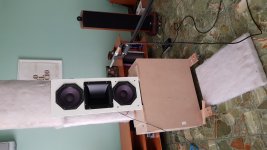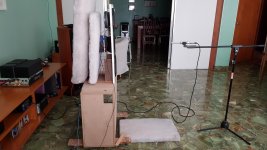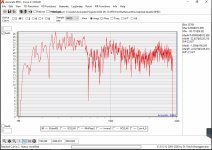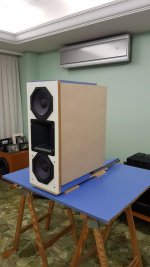I measured the twin 8PE21 today. Attached pictures of the setup:
- I added the panels behind (fiberglass) to attempt to mitigate the back wall reflection. Same for panel on floor.
- Mic stands at 50cm from front baffle. The 8PE21 are 45cm apart, so I figured it was a better balance between being close to minimize reflection effect vs being too close that would be too off axis for the 8-inchers.
- Measured 200 to 3000Hz, looking to linearize between 250 and 3000Hz (xo to TPL estimated at 1600Hz).
Attachments
Last edited:
Take both horizontal and vertical 0-90 from 1m.
Good you have proper mic, can you do 2-channel measurements?
Good you have proper mic, can you do 2-channel measurements?
I wouldn't try to make this flat to your response measurement. You haven't considered what is happening with the baffle, or the cone. You may just run it out of range.Measured 200 to 3000Hz, looking to linearize between 250 and 3000Hz
I wouldn't try to make this flat to your response measurement. You haven't considered what is happening with the baffle, or the cone. You may just run it out of range.
Not sure I'm understanding. This driver is spec'ed by B&C for 90 to 5000Hz, and 250 to 3000Hz looks rather undemanding from the uncorrected measurement on the post from today. What am I missing?
Try to smooth to at least 1/12 octave if not 1/6.I measured the twin 8PE21 today.
B&C recommend 5k? as a direct radiator?
I'm not sure why you'd flatten, it shouldn't be a problem detecting the fundamental lobing issues through the apparent noise of normal looking responses.
I'm not sure why you'd flatten, it shouldn't be a problem detecting the fundamental lobing issues through the apparent noise of normal looking responses.
I think it depends on what you are trying to measure, right? I was measuring to linearize the driver thru Acourate, and measuring close is appropriate for that end.
Looked into your pdf. Seemed you liked it at the time. Will take another look.
How would you go about measuring the M-M driver compliment? 1m away, on axis with tweeter?
Thanks for the input!
I would only ever measure closer than 1 meter if I was doing a near field for a low frequency driver. There’s no reason otherwise to measure closer if you have the ability to gate the response using FFT. REW and ARTA can do this quite easily and is critical for removing the room from your measurements.
Typically you’ll want the mic distance at least two times the greatest distance across your baffle. If your baffle is 60cm high then I’d measure at least 120cm away.
B&C recommend 5k? as a direct radiator?
I'm not sure why you'd flatten, it shouldn't be a problem detecting the fundamental lobing issues through the apparent noise of normal looking responses.
This is the approach I was going to take, but can easily change it if not the best:
- Create the active xo on Acourate (1.6kHz BW3, for starters). Linearize drivers, time-align. Install the filters.
- Measure the MTM "unit" with REW at 1m (or should it be 2m since that's the listening distance?), at varying angles and varying heights. I was expecting this to show signs of lobbing.
- Arrive at some conclusions, iterate steps above, iterate again until heart's contempt.
But maybe I'm complicating it unnecessarily. From your comment it seems I might not need to implement the active xo to assess lobbing. Could you elaborate?
FWIW, B&C doesn't say "recommended" frequency range, but "90 - 5000Hz frequency response" on their spec sheet. I'm not planning to use it above 2kHz nor below 250Hz, though.
I would be interested in the directivity of the woofers and the tweeter. Choose where to use them. Can they fit together? Change the dimensions, the acoustic design. This is what I think you are trying to do. If you add filters you can't see how they behave at all frequencies.
If you jump ahead and measure all three drivers at once, you won't know if there is a proper solution, you can only try.. Both W and T get narrow around 2k5. How can you fix this in a crossover. (The way I would begin to fix this is to modify the horn so the tweeter can cover 2-3k, but first I would understand how the two woofers work together)
BTW, Why on-axis? You know the breakup peak is high on-axis, that is not fair.
If you jump ahead and measure all three drivers at once, you won't know if there is a proper solution, you can only try.. Both W and T get narrow around 2k5. How can you fix this in a crossover. (The way I would begin to fix this is to modify the horn so the tweeter can cover 2-3k, but first I would understand how the two woofers work together)
BTW, Why on-axis? You know the breakup peak is high on-axis, that is not fair.
BTW, Why on-axis? You know the breakup peak is high on-axis, that is not fair.
Ahh!! You give me too much credit!!😱
No, I didn't know. Would 15 degrees off axis horizontally be ok?
I would be interested in the directivity of the woofers and the tweeter. Choose where to use them. Can they fit together? Change the dimensions, the acoustic design. This is what I think you are trying to do. If you add filters you can't see how they behave at all frequencies.
OK, measuring tweeter and woofers separately is easy. I thought the xo region, measuring the MTM was most critical. But can definitely take REW to maesure T and MM separately.
FWIW, I can't really change the center-to-center dimensions unless I change drivers. The twin woofers are as close as I can get without cutting into the TPL horn.
(The way I would begin to fix this is to modify the horn so the tweeter can cover 2-3k, but first I would understand how the two woofers work together)
Indeed, making a larger wooden horn for the tweeter wouldn't be out of the plans. Same thing for an enlarged back chamber. But I envision both as improvements over a working starting point (which I'm trying to develop)
Yes, it is all one big compromise. This is OK, you can still have success once you find the best compromise. What matters is that you think about the whole system each time you make changes.
If you look at the woofer lobing, you watch the frequencies getting higher and the vertical getting narrow. Then at a higher frequency the lobing becomes complicated and too narrow in the middle. Somewhere you want to find a place where you can stop using it.. Somewhere the tweeter can join in.
This means you can still change the crossover frequency. If you do, you sometimes need to change the filter slopes at the same time.I can't really change the center-to-center dimensions unless I change drivers.
Yes, ok but what if one way is not contributing much.I thought the xo region, measuring the MTM was most critical.
If you look at the woofer lobing, you watch the frequencies getting higher and the vertical getting narrow. Then at a higher frequency the lobing becomes complicated and too narrow in the middle. Somewhere you want to find a place where you can stop using it.. Somewhere the tweeter can join in.
Take both horizontal and vertical 0-90 from 1m.
Good you have proper mic, can you do 2-channel measurements?
Will do.
BTW, do you happen to know what kind of mods does Dieter Achenbach performs to the TPL-150H he sells? He sells a kit with this molded driver plus 2x 8" PHL in MTM. I'm wondering what he might be doing to the TPL?
After reading this thread I find it intriguing but also confounding. I think the real issue here is "Are you already extremely familiar with active crossovers?" I'm not sure how to properly time align with two drivers let alone three drivers in an MTM design. Maybe you need to find out what sounds best with just two drivers (The TPL150 and the 8 inch woofer) before trying to set up an MTM. Maybe you don't have a choice but it seems like it's gotten exponentially more difficult due to active crossovers. You have to account for an increase in db with two woofers that are independently amplified so you need the frequency curve there for the combined woofers. You need to cross low enough (I'm guessing around 24 db slope) at 1200hz to limit lobing beyond 3 feet? Whats the sensitivity of the two woofers combined compared to the sensitivity of the tpl150? Does your software/active crossover allow you to create slopes and reduce volume. The horn simply allows you to cross over a a little lower to 1000 hz before distorting at the crossover point for tpl150. I wouldn't worry about the 8 inchers if they're good to 3000hz as a 24db slope is plenty good there for distortion. I'm more knowledgeable about passive vs. active crossovers as I've heard time alignment can be a pain in the **** with active. I know I'm creating more questions than answers but I hope it helps you think more about what doing.
I think the real issue here is "Are you already extremely familiar with active crossovers?" I'm not sure how to properly time align with two drivers let alone three drivers in an MTM design.
Well...it's all relative. I don't consider myself extremely familiar with it, but I've been using digital active crossovers done with Acourate for at least 5 years, do run an active system now and time align tweeter and midrange relatively easily. The challenge with time-alignment is subwoofers.
Maybe you need to find out what sounds best with just two drivers (The TPL150 and the 8 inch woofer) before trying to set up an MTM. Maybe you don't have a choice but it seems like it's gotten exponentially more difficult due to active crossovers. You have to account for an increase in db with two woofers that are independently amplified so you need the frequency curve there for the combined woofers. You need to cross low enough (I'm guessing around 24 db slope) at 1200hz to limit lobing beyond 3 feet? Whats the sensitivity of the two woofers combined compared to the sensitivity of the tpl150? Does your software/active crossover allow you to create slopes and reduce volume. The horn simply allows you to cross over a a little lower to 1000 hz before distorting at the crossover point for tpl150. I wouldn't worry about the 8 inchers if they're good to 3000hz as a 24db slope is plenty good there for distortion. I'm more knowledgeable about passive vs. active crossovers as I've heard time alignment can be a pain in the **** with active. I know I'm creating more questions than answers but I hope it helps you think more about what doing.
mmm...I think you haven't seen earlier posts in this thread. Most of the answers to you comments are there: why I'm doing MTM, what's the tweeter and midranges sensitivities, what the software allows to adjust, the lowest tweeter xo point.
Active is way easier if delay is needed.I'm more knowledgeable about passive vs. active crossovers as I've heard time alignment can be a pain in the **** with active.
If you collect all the data you simply can simulate it with software in silence.
fine tuning directivity with out simulating software you are looking for hundreds of rew sweeps and thousands hours.
Or you just win a lottery and got is right on first settings
Typically you’ll want the mic distance at least two times the greatest distance across your baffle. If your baffle is 60cm high then I’d measure at least 120cm away.
AllenB said:I would be interested in the directivity of the woofers and the tweeter. Choose where to use them. Can they fit together? Change the dimensions, the acoustic design. This is what I think you are trying to do. If you add filters you can't see how they behave at all frequencies.
and manninen recommended measuring 0-90 degrees horizontal and vertical.
I'll do all that tomorrow:
- Measure, separately, uncorrected tweeter and uncorrected MM
- Measure at 15 degree intervals horizontal and vertical
- Measure at 1 meter. Baffle is 30cm, so 1 meter will satisfy Joseph's recommendation to measure at least at twice the baffle width.
Question: what consists a 15 degree off axis vertically for the MM? The mic will be centerline horizontally, 1m away from the baffle, pointing straight ahead, and 27cm above tweeter vertical centerline. Correct? So the mic will be closer to one woofer than the other.
And if you wanna use that data in simulation software they have to be 2-channel measurements
Yes, 2 channel measurements.
BTW, I was able to repurpose another box I had to bemoan the enclosure, so the back wave concerns are taken out of the equation. Looks better in the picture than what it actually is, but fits the purpose ��
For some reason this website doesn't rotate pictures from my phone...
Attachments
Last edited by a moderator:
- Home
- Loudspeakers
- Multi-Way
- Lobing in MTM with TPL-150H and 8PE21





